|
Philadelphia Memories (Part II)
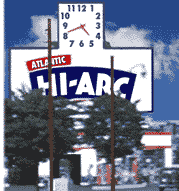 Hi-Arc: The Atlantic Oil Company of Philadelphia, Pennsylvania used to sell Hi-Arc brand gasoline. In Northeast Philadelphia, there was a small gas station on the Oxford Circle roundabout with a very large Hi-Arc sign which dominated the neighborhood skyline. The huge billboard-type sign with its distinctive clock face first appeared in the 1930s. Hi-Arc: The Atlantic Oil Company of Philadelphia, Pennsylvania used to sell Hi-Arc brand gasoline. In Northeast Philadelphia, there was a small gas station on the Oxford Circle roundabout with a very large Hi-Arc sign which dominated the neighborhood skyline. The huge billboard-type sign with its distinctive clock face first appeared in the 1930s.
Oxford Circle is made up of the intersection of Oxford Avenue, Cheltenham Avenue, Castor Avenue and the 12-lane Roosevelt Boulevard. This has always been a busy and oft treacherous intersection but was particularly so prior to 1950, when the Route 59 trolley ran right through the grassy center of the large circle.
When the trolley cars were replaced by trolley buses (Philadelphians referred to them as 'trackless trolleys'), the buses traveled along Oxford Avenue and went around the circle with all the other vehicular traffic.
The Circle was made even safer with the construction of an underpass for six express lanes of Roosevelt Boulevard; it opened in 1956 or so.
Atlantic Oil later merged with Richfield Oil to form ARCO, which later became part of BP. After an unsuccessful spinoff from ARCO, Atlantic was acquired by Sunoco in 1988 and over the next eight or so years, all stations were converted to the Sunoco brand.
Today, the dominant structure around Oxford Circle is Saint Martin of Tours Church. The current church was a simple, flat-roofed, one-story stone structure built in the early 1930s and designed to accept a more grandiose upper level as the parish expanded and as funds became available. Church construction then had to be postponed due to WWII and, later, Korean War steel shortages.
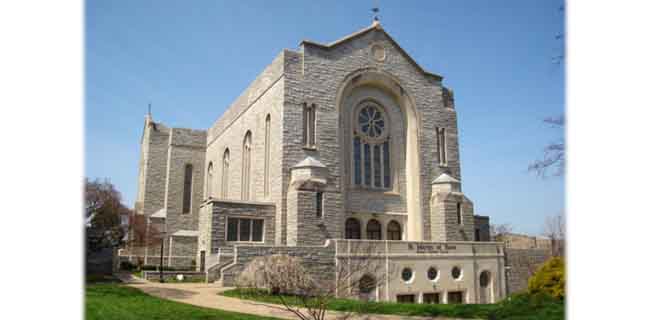
Saint Martin's impressive, basilica-like upper church was finally completed in 1955. (posted 6/2/08, permalink)
Another Sign Of End Times: A Philadelphia restaurant is offering a $100 cheesesteak, made with Kobe beef, butter poached lobster, shaved truffles and $17/pound cheese. Chef James Locascio, of Barclay Prime, claims to sell six to seven per night at his tony Rittenhouse Square restaurant. Some are ordered as appetizers.
When I was in high school, you could get a cheesesteak for 65¢. Even in the Rittenhouse Square area. (posted 5/19/08)
Moving Advertising - Transit Ads: In Philadelphia (and many other cities), commercial advertising was placed on the inside and outside of trolley cars to provide an additional source of revenue for transit companies. Here is a selection of exterior placards from 1940s and '50s Philadelphia street cars:

Schmidt's Bock Beer, a strong, heavy beer - richer in taste than regular lager, was usually marketed in the Spring. The sign features an illustration of a horned goat. The word 'bock' in German is also the term for 'billygoat'.
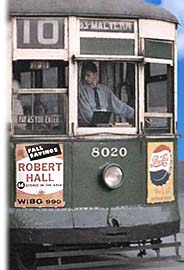 Ram's Head Ale was made by the Adam Scheidt Brewing Co. of nearby Norristown, PA. The brewery was sold to C. Schmidt and Sons brewery of Philadelphia in 1954. Ram's Head Ale was made by the Adam Scheidt Brewing Co. of nearby Norristown, PA. The brewery was sold to C. Schmidt and Sons brewery of Philadelphia in 1954.
Mission Bell Wines was a national brand, a sponsor of Bob and Ray's radio show.
"Fun!" declareed the Broad Street Driving School. I can't imagine that it would be 'fun' to learn to drive on Broad Street, a busy Philly thoroughfare even in the '40s and '50s.
Adams Rug Cleaning and Storage "delighted 150,000 customers". Adams was also a big user of subway placards and spot radio ads. I remember seeing the firm's Metro step vans plying neighborhood streets, picking up rugs to clean and/or store. I remember when people "took their rugs up" for the summer, exposing a hardwood floor which would be covered with a few throw rugs.
Margo Quality Wines offered 'New Low Prices', according to the placard. This Philadelphia-based retailer of low-priced wines also offered Bis-Kay California Wines.
Seiler's Goose Neck Liverwurst was a product of Karl Seiler & Sons of Philadelphia. The company also offered smoked and cured meats - bacon, bologna, dried beef, boneless butts, ham, luncheon roll, meat loaf, pork roll, sausage, and scrapple.
Valley Forge Beer was the primary brand of the Adam Scheidt Brewing Co. of Philadelphia (1870-1954).
Pepsi Cola: 'The light refreshment': In the '40s and '50s, Coca Cola was a heavier-tasting brand. Pepsi was positioned as a 'value brand', offering a lighter taste and more ounces of soda per bottle. 'Costs a nickel - worth a dime' was Pepsi's slogan during that era. Pepsi was probably the largest advertiser in the Philadelphia trolley ad business. It seemed like every third trolley car carried a Pepsi placard somewhere on its exterior. Coca-Cola did not participate in trolley ads, relying on the familiar enameled red circle on luncheonette and diner signs instead.

Robert Hall was a national clothing retailer, based out of Connecticut. They were famous for their plain stores full of clothing racks; Hall offered budget but reasonably well-made clothing, mainly men's suits, pants and sport coats. Most suits came with two pairs of pants. Womens clothing was offered in some stores. Hall had a memorable radio jingle: "When values go up, up, up ... And prices go down, down, down ... Robert Hall this season ... Will show you the reason ... Low overhead, Low overhead."
I've incorporated some advertising placards on the O-gauge Brill PTC trolley which runs on the lower level of my model train layout. (posted 4/23/08, permalink)
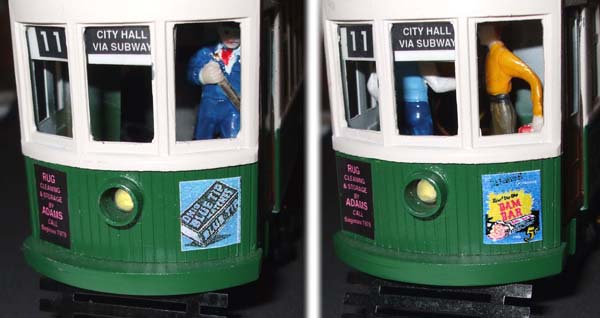
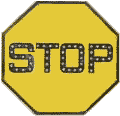 Remember Yellow? Once upon a time, stop signs were yellow, not red. Yellow signs were the norm when I was a youngster in Philadelphia. Remember Yellow? Once upon a time, stop signs were yellow, not red. Yellow signs were the norm when I was a youngster in Philadelphia.
There were numerous colors used for stop signs until 1924, when yellow was standardized as the background color for maximum day and night visibility. Signs were either painted or enameled back in those days and red signs had almost no reflectivity, making them very dark and virtually invisible at night. Some stop signs were crafted from painted wood; others were tin. The most durable ones were made of heat-fired porcelain enamel applied to a steel backing. Some signs also had "button-copy" lettering - small glass "cat's eye" reflectors attached to the sign face.
The black on yellow octagonal stop sign was the U.S. standard until a 1954 revision to the MUTCD (Manual on Uniform Traffic Control Devices). State highway departments made the conversion to white over red stop signs over a three year period. However, yellow stop signs existed for many more years on lightly-traveled local roads.
By the 1950s, red (far more visible than yellow in daylight) could finally be used due to technological progress. 3M's Scotchlite, a reflective sheet material, had glass beads in embedded in it to reflect headlight beams back at the driver from the entire sign surface, 'illuminating' the sign at night. Scotchlite was first tried in the early 1940s. By the 1950s, outdoor durability of the material was sufficiently proven that Scotchlite could be specified for outdoor reflective signs, such as stop signs. (posted 4/11/08, permalink)
Signs Of The Times: I've been looking at old photos of Philadelphia and have been amazed by some of the signage I've seen:

Reddy Kilowatt urged folks to 'Be Modern - Cook Electrically'. No mention of greenhouse emissions from non-scrubber, bituminous-fueled generating plants. Nor of energy efficiency.
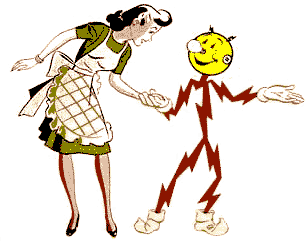 Reddy, the corporate spokesman for electricity generation in the U.S., was created in 1926 by the Alabama Power Company. He was subsequently licensed by some 300 U.S. electrical companies, looking to sell homeowners on using the relatively new technology. Reddy, the corporate spokesman for electricity generation in the U.S., was created in 1926 by the Alabama Power Company. He was subsequently licensed by some 300 U.S. electrical companies, looking to sell homeowners on using the relatively new technology.
Mr. Kilowatt is not the only power mascott. Reddy Flame is a character promoting the use of natural gas.
And, on The Simpsons, Smilin' Joe Fission is the cartoon advocate of the Springfield Nuclear Power Plant: "Hi there, energy eaters. ... Whoops. Looks like there's a little leftover nuclear waste. No problem. I'll just put it where nobody'll find it for a million years." Smilin' Joe then uses a broom to hide the nuclear waste under a carpet.
Porto Rico was one of many local/regional brands of soda pop found across America in the 1940 and '50s. Before Coke and Pepsi put the little independent bottlers out of business. When Coke supplied servicemen all over the world with product dring World War II, it was one of the smartest product placement moves ever made. Once hooked on cola, people abandoned Pale Dry Ginger Ale, Frank's Black Cherry Wishniak (a Philly favorite) and other now-obscure soda pop flavors and local offerings in favor of large national cola brands.
Here's some more fierce competition: A Penn Jersey auto parts store operated next door to a Pep Boy's in South Philadelphia.
Esslinger's Beer - 'Switch To The Million Dollar Flavor'- was featured on a clock billboard. Philadelphia was chock full of beer ads (and local breweries) back in those days. Esslinger's, Inc., a local operation, was founded in 1879 by George Esslinger. The firm closed in 1964.
Then there were signs with a graphic clearly describing the business - in case you couldn't read/see well:
Fierce Competition: Many people think that targeted, saturation competition - opening a Burger King across from McDonalds, a Starbucks up the street from a local coffee house, etc. - is a new thing.
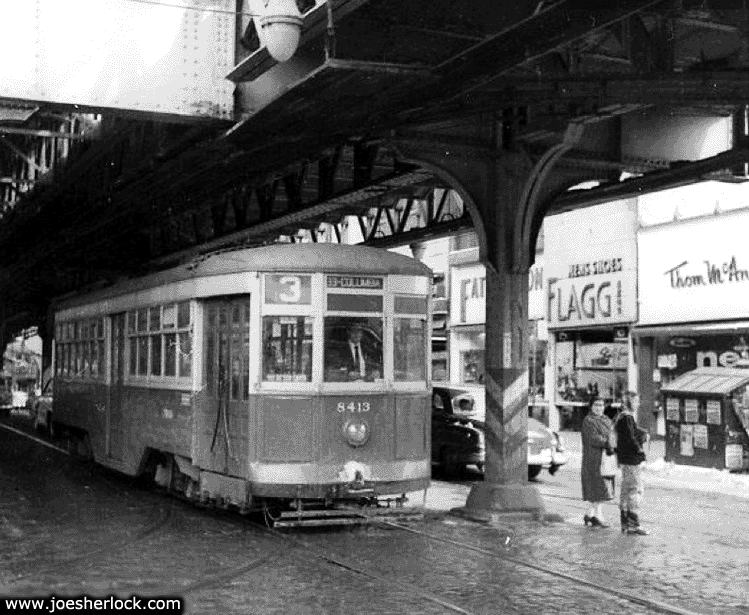
Three shoe stores - Father & Son Shoes, Flagg Bros. and Thom McAn - are next door to one another in an early 1950s photo taken under the Frankford El tracks at the corner of Frankford Avenue and Orthodox St. in Philadelphia, PA.
This is capitalism at its most intense. Battle to the death. Winner take all. (posted 3/19/08, permalink)
Bandstand: In late 2004, Dick Clark suffered a stroke. It's hard to believe I'm using "Dick Clark" and "stroke" in the same sentence. Whenever I think of Dick Clark, I think of Bandstand. In late 1952, television station WFIL in Philadelphia started a local daily afternoon dance program, Bandstand. It was a two-and-a-half hour show, featuring Philadelphia radio personalities Lee Stewart and Bob Horn.
My memory as a 9 year-old is that Lee Stewart was a jerk and Bob Horn was an unsavory-looking guy. Stewart soon left and Horn became the sole host. In 1955 or 56, Bob Horn was fired for what the Philadelphia Evening Bulletin euphemistically referred to as "taking liberties with one of the underage female regulars in his dressing room."
WFIL frantically searched for a squeaky-clean replacement and selected Dick Clark, a 26-year-old Philadelphia radio announcer. Clark fit the role well and, on August 5, 1957, the show went national. A 90-minute version of the two and one-half hour show - renamed American Bandstand - was carried by ABC and became an instant success.
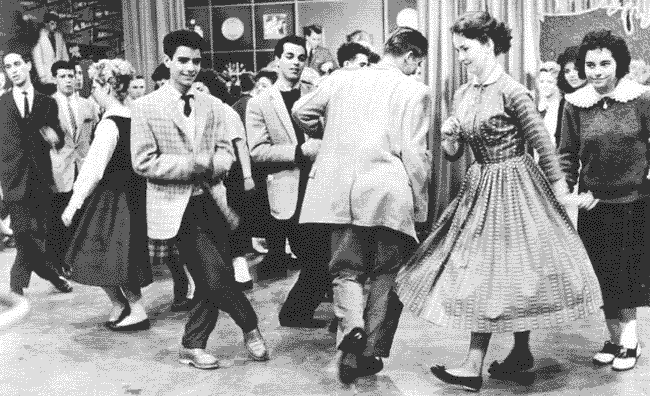
Contrary to popular conceptions ... (more >>>)
Pep Boys - Philly Legends: Whenever I think of Pep Boys, I recall its old house brands - Cornell Tires, Cadet batteries, Pure-as-Gold motor oil, Varsity auto accessories and Dur-Alloy mufflers. Pep Boys started in Philadelphia in 1921. By the way, Manny, Moe and Jack were real-life people - the founders of Pep Boys.
In 1933, Moe Strauss moved to Southern California and opened stores there, but ... (more >>>)
In Philadelphia, Nearly Everybody Reads ... The Philadelphia Evening Bulletin was resurrected in late 2004. The original Bulletin was a highly regarded afternoon paper published daily and Sunday from 1874 to 1982. Philadelphia was once divided into two camps - Bulletin people and Inquirer people. Different tastes, different views, different comics.
My family ... Bulletin people. I married a girl whose family were Philadelphia Inquirer people. (Who says mixed marriages don't work?!) The new Bulletin is also an afternoon paper, published Monday through Friday, sell for 25 cents and have a conservative slant.
The old Bulletin's slogan was: "In Philadelphia, Nearly Everybody Reads The Evening Bulletin."
| NEXT PAGE |
Other Pages Of Interest
copyright 2004-21 - Joseph M. Sherlock - All applicable rights reserved
Disclaimer
The facts presented on this website are based on my best guesses and my substantially faulty geezer memory. The opinions expressed herein are strictly those of the author and are protected by the U.S. Constitution. Probably.
Spelling, punctuation and syntax errors are cheerfully repaired when I find them; grudgingly fixed when you do.
If I have slandered any brands of automobiles, either expressly or inadvertently, they're most likely crap cars and deserve it. Automobile manufacturers should be aware that they always have the option of trying to change my mind by providing me with vehicles to test drive.
If I have slandered any people or corporations, either expressly or inadvertently, they should buy me strong drinks (and an expensive meal) and try to prove to me that they're not the jerks I've portrayed them to be. If you're buying, I'm willing to listen.
Don't be shy - try a bribe. It might help.
|

